Name Eugene Shoemaker | Spouse Carolyn S. Shoemaker | |
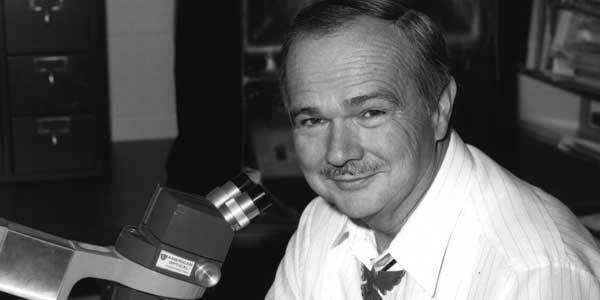 | ||
Born April 28, 1928Los Angeles, California, U.S. ( 1928-04-28 ) Alma mater California Institute of TechnologyPrinceton Notable awards G. K. Gilbert Award (1983)Barringer Medal (1984)National Medal of Science (1992)William Bowie Medal (1996)James Craig Watson Medal (1998) Awards Similar People Carolyn S Shoemaker, David H Levy, Eleanor F Helin, Luis Walter Alvarez, Alan Hale | ||
TODAY IN HISTORY - Birthday of Dr. Eugene Merle Shoemaker - 28 Apr 2011
Eugene Merle Shoemaker (April 28, 1928 – July 18, 1997), also known as Gene Shoemaker, was an American geologist and one of the founders of the field of Planetary science. He is best known for co-discovering the Comet Shoemaker–Levy 9 with his wife Carolyn S. Shoemaker and David H. Levy. This comet hit Jupiter in July 1994: the impact was televised around the world.
Contents
- TODAY IN HISTORY Birthday of Dr Eugene Merle Shoemaker 28 Apr 2011
- Early life and formal education
- Family
- Scientific contributions
- Astrogeology and Apollo
- Comet ShoemakerLevy 9
- Death
- Awards and Tributes
- References
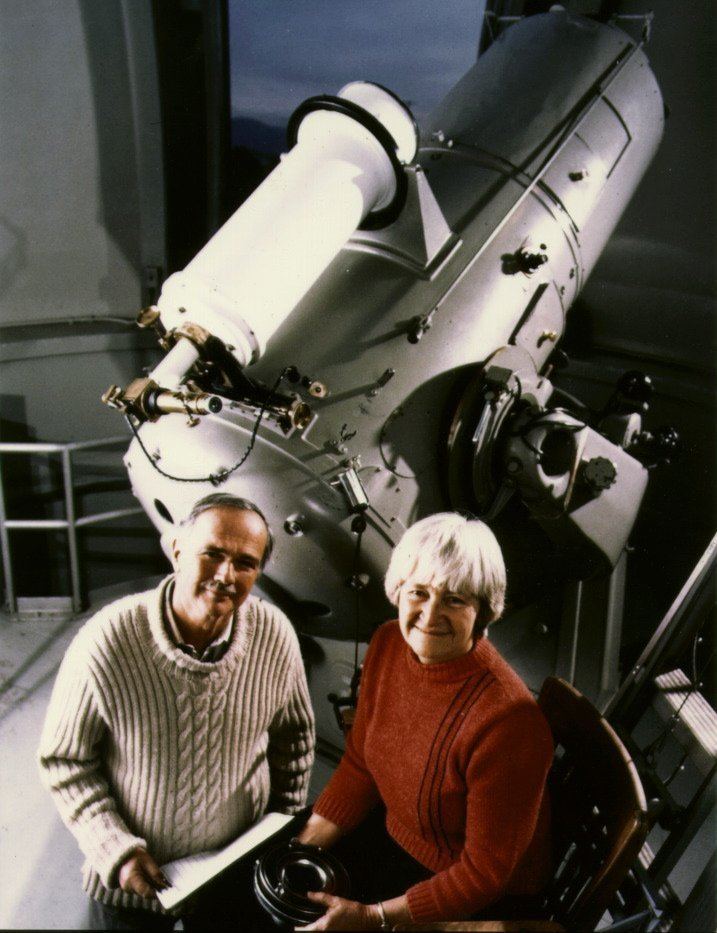
Shoemaker was also well-known for his studies of terrestrial craters, such as Barringer Meteor Crater in Arizona. Shoemaker was the first scientist to conclude that these craters were caused by meteor impact. Shoemaker was also the first director of the United States Geological Survey's astrogeology Research Program.

Early life and formal education
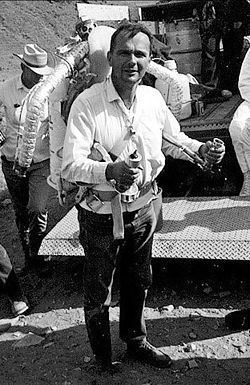
Shoemaker was born in Los Angeles, California, the son of Muriel May (née Scott), a teacher, and George Estel Shoemaker, who worked in farming, business, teaching, and motion pictures. His parents were natives of Nebraska. During Gene's childhood they moved between Los Angeles, New York City, Buffalo, New York and Wyoming, as George worked on a variety of jobs. George hated living in big cities, and was quite satisfied to take a job as director of education for a Civilian Conservation Corps (CCC) camp in Wyoming. His wife soon found life in a remote cabin quite unsatisfactory. They compromised, when Muriel got a teaching job in Buffalo. She could teach in the Buffalo School of Practice (sic) during the school year while keeping Gene with her, then both would return to Wyoming during the summers. Gene's passion for studying rocks was ignited by the science education courses offered by the Buffalo Museum of Education. He enrolled in the School of Practice in the fourth grade, and began collecting samples of minerals. Within a year, he was also taking high-school-level evening courses. The family moved back to Los Angeles in 1942, where Gene enrolled in Fairfax High School at the age of thirteen. He completed high school in three years. During that time he also played violin in the school orchestra, excelled in gymnastics, and got a summer job as an apprentice lapidary.

Gene enrolled in the California Institute of Technology (Caltech) in 1944, at the age of sixteen. His classmates were older, more mature and on a fast track to graduate before serving in World War II. Gene thrived in the fast pace and earned his bachelor's degree in 1948, at age nineteen. He immediately undertook the study of Precambrian metamorphic rocks in northern New Mexico, earning his M. Sc. degree from Caltech in 1949.
Family

While Gene was attending Caltech, his roommate was Richard Spellman, a young man from Chico, California. Although Gene had already enrolled in a doctoral program at Princeton University, Gene returned to California, to serve as best man at Richard's wedding in 1950. He met Richard's sister, Carolyn, for the first time on that occasion. Carolyn had been born in Gallup, New Mexico in 1929, but the Spellman family had moved to Chico soon afterward. Carolyn had earned degrees from Chico State College in history and political science. She had never exhibited any interest in scientific subjects while growing up, and had taken one geology course in college, which she had found quite boring. Nevertheless, the couple formed a "pen pal" relationship while Gene spent the next year in Princeton, followed by a two-week vacation touring the Colorado Plateau. She reportedly told others that,"listening to Gene explaining geology made what she had thought was a boring subject into an exciting and interesting pursuit of knowledge." The couple married on August 17, 1951.
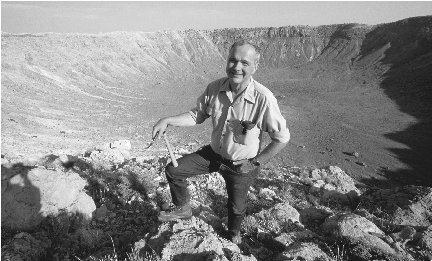
The Shoemakers had three children: two daughters and one son. Carolyn saw her work as keeping house and raising the children especially after they settled in Flagstaff in the 1960s. She had tried teaching school before they married, but found the work unsatisfying. She also traveled sometimes with Gene, but stopped after she noticed that her absence affected the children. After their children were grown, Carolyn wanted something meaningful to combat the "empty nest" feeling. By then, Gene suggested that she take up astronomy and join his team looking for asteroids approaching Earth. A student working at Lowell Observatory commenced teaching her astronomy. She showed great potential and launched her career as a planetary astronomer at age 51. She continues the work to the present.
Scientific contributions
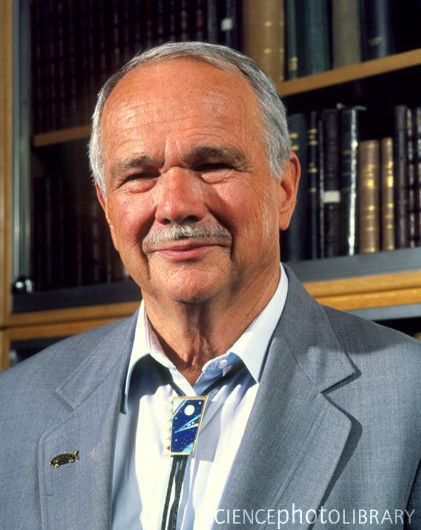
The United States Geological Survey (USGS) hired Shoemaker in 1950. His first assignment was to search for uranium deposits in Utah and Colorado. His next mission was to study volcanic processes, since other investigators had already noticed that uranium deposits were often located in the vents of ancient volcanoes. This study led him to explore the Hopi Buttes of Northern Arizona, which happened to be near Meteor Crater.
Daniel Barringer, an entrepreneur and mining engineer who had discovered Meteor Crater in 1891, had postulated that it had been caused by the impact of a meteor. About the same time, G. K. Gilbert, the chief geologist of the USGS, examined the crater and announced that it had been created by an explosive venting of volcanic steam. A majority of scientists accepted Gilbert's explanation of the cause of the crater, This theory remained as conventional wisdom until Shoemaker's investigations a half century later.
Astrogeology and Apollo
For his Ph.D. degree at Princeton (1960), Shoemaker studied the impact dynamics of Barringer Meteor Crater, located near Winslow, Arizona. To understand the dynamics, Shoemaker inspected craters that remained after underground atomic bomb tests at the Nevada Test Site at Yucca Flat. He found a ring of ejected material that included shocked quartz (coesite), a form of quartz that has a microscopically unique structure caused by intense pressure.
Shoemaker helped pioneer the field of astrogeology by founding the Astrogeology Research Program of the United States Geological Survey in 1961 at Flagstaff, Arizona and he was its first director. He was prominently involved in the Lunar Ranger missions to the Moon, which showed that the Moon was covered with a wide size range of impact craters. Shoemaker was also involved in the training of the American astronauts. He himself was a possible candidate for an Apollo Moon flight and was set to be the first geologist to walk on the Moon but was disqualified due to being diagnosed with Addison's disease, a disorder of the adrenal gland. Shoemaker would train astronauts during field trips to Meteor Crater and Sunset Crater near Flagstaff. He was a CBS News television commentator on the early Apollo missions, especially the Apollo 8 and Apollo 11 missions, appearing with Walter Cronkite during live coverage of those flights.
He was awarded the John Price Wetherill Medal from the Franklin Institute in 1965.
Coming to Caltech in 1969, he started a systematic search for Earth orbit-crossing asteroids, which resulted in the discovery of several families of such asteroids, including the Apollo asteroids. Shoemaker advanced the idea that sudden geologic changes can arise from asteroid strikes and that asteroid strikes are common over geologic time periods. Previously, astroblemes were thought to be remnants of extinct volcanoes — even on the Moon.
Comet Shoemaker–Levy 9
Shoemaker received the Barringer Medal in 1984 and a National Medal of Science in 1992. In 1993, he co-discovered Comet Shoemaker–Levy 9 using the 18-inch Schmidt camera at Palomar Observatory. This comet was unique in that it provided the first opportunity to observe the planetary impact of a comet. Shoemaker–Levy 9 collided with Jupiter in July 1994. The resulting impact caused a massive "scar" on the face of Jupiter. Most scientists at the time were dubious of whether there would even be any evident markings on the planet.
Death
Shoemaker spent much of his later years searching for and finding several previously unnoticed or undiscovered impact craters around the world.
Shoemaker died on July 18, 1997 during one such expedition in a car collision near Alice Springs, Australia. Shoemaker's wife Carolyn was severely injured in the crash.
On July 31, 1999, some of his ashes were carried to the Moon by the Lunar Prospector space probe in a capsule designed by Carolyn Porco. He is the only person whose ashes have been buried on any celestial body outside Earth.
The brass foil wrapping of Shoemaker's memorial capsule is inscribed with images of Comet Hale–Bopp ("the last comet that the Shoemakers observed together"), the Barringer Meteor Crater, and a quotation from Shakespeare's Romeo and Juliet reading
The fatal crash had happened when Hale-Bopp was still visible to the naked eye, having passed perihelion and having moved into the southern celestial hemisphere.
Awards and Tributes
Gene Shoemaker received a large number of awards for his professional work. According to the obituary published by the USGS Astrogeology Science Center, these included:
On July 24, 1997, a memorial for Dr. Eugene Shoemaker and Dr. Jurgen Rahe was presented in the U.S. House of Representatives by California representative George E. Brown, Jr. The memorial was published in the Congressional Record. The memorial credited Shoemaker with being either the discoverer or co-discoverer of 820 asteroids and comets during his career.
A ring-like topographic feature in Western Australia, an astrobleme previously named the "Teague ring" was renamed "Shoemaker Crater" in honor of Eugene M. Shoemaker.
The Near Earth Asteroid Rendezvous space probe was renamed "NEAR Shoemaker" in his honor. It arrived at asteroid 433 Eros in February 2000, and landed on the asteroid after a year of orbital study. He was previously honored with the asteroid 2074 Shoemaker, discovered and named by his colleague, Eleanor F. Helin.
